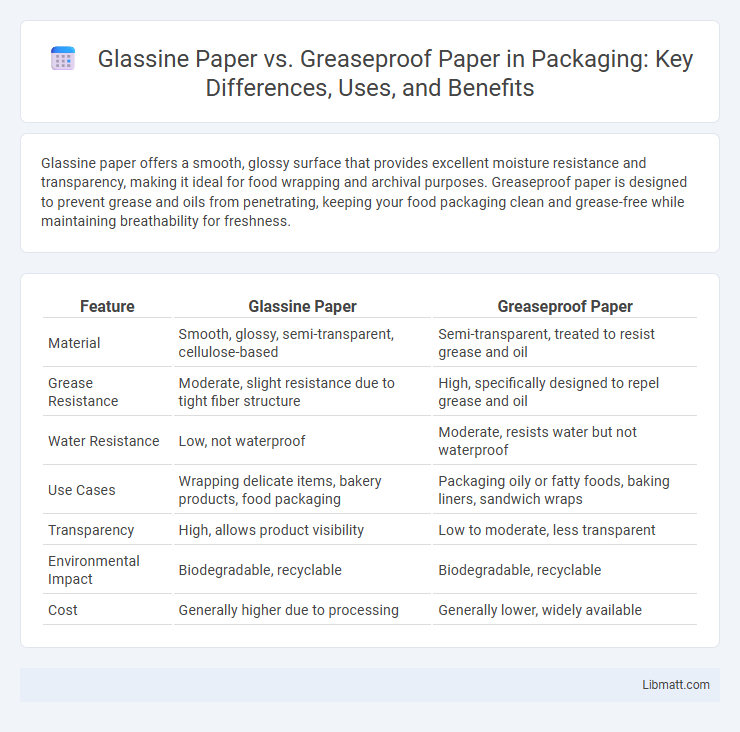Glassine paper offers a smooth, glossy surface that provides excellent moisture resistance and transparency, making it ideal for food wrapping and archival purposes. Greaseproof paper is designed to prevent grease and oils from penetrating, keeping your food packaging clean and grease-free while maintaining breathability for freshness.
Table of Comparison
| Feature | Glassine Paper | Greaseproof Paper |
|---|---|---|
| Material | Smooth, glossy, semi-transparent, cellulose-based | Semi-transparent, treated to resist grease and oil |
| Grease Resistance | Moderate, slight resistance due to tight fiber structure | High, specifically designed to repel grease and oil |
| Water Resistance | Low, not waterproof | Moderate, resists water but not waterproof |
| Use Cases | Wrapping delicate items, bakery products, food packaging | Packaging oily or fatty foods, baking liners, sandwich wraps |
| Transparency | High, allows product visibility | Low to moderate, less transparent |
| Environmental Impact | Biodegradable, recyclable | Biodegradable, recyclable |
| Cost | Generally higher due to processing | Generally lower, widely available |
Introduction to Glassine and Greaseproof Paper
Glassine paper is a smooth, glossy, and translucent material coated to resist air, water, and grease, making it ideal for food wrapping and archival storage. Greaseproof paper, on the other hand, is a porous, uncoated paper specially treated to prevent grease absorption while allowing breathability, commonly used for baking and food packaging. Both papers serve distinct purposes based on their unique resistance properties and texture.
What is Glassine Paper?
Glassine paper is a smooth, glossy, and translucent paper that is air, water, and grease resistant due to its supercalendered finish. It is commonly used for food packaging, archival materials, and protective interleaving because of its high resistance to oils and moisture. Unlike greaseproof paper, which is porous and treated chemically to resist grease, glassine offers a more durable and non-porous barrier, making it ideal for preserving the integrity of delicate items.
What is Greaseproof Paper?
Greaseproof paper is a type of paper specifically treated or manufactured to resist the penetration of grease and oil, making it ideal for food wrapping and packaging applications. Unlike glassine paper, which is smooth and translucent with low air permeability, greaseproof paper is usually opaque and absorbs minimal grease while maintaining breathability to prevent sogginess. Its unique manufacturing process involves refining pulp fibers to create a dense, non-porous sheet that provides effective grease resistance without additional coatings or chemicals.
Key Differences Between Glassine and Greaseproof Paper
Glassine paper is a smooth, glossy, and translucent paper primarily used for its resistance to air, water, and grease, making it ideal for packaging delicate items like food and stamps. Greaseproof paper, on the other hand, is opaque and designed specifically to block grease and oil, commonly used for wrapping oily foods and baking purposes. Your choice between these papers depends on whether you need a transparent barrier with high density (glassine) or a robust, oil-resistant layer that maintains opacity (greaseproof).
Common Uses of Glassine Paper
Glassine paper is commonly used in food packaging, particularly for wrapping baked goods, candy, and chocolates due to its grease-resistant and moisture-resistant properties. It is also utilized in archival storage for protecting photographs, stamps, and artwork because of its smooth, non-stick surface that prevents damage. Your choice of glassine paper can enhance product presentation and preservation in various packaging and preservation applications.
Common Uses of Greaseproof Paper
Greaseproof paper is commonly used in cooking and baking to prevent food from sticking and to contain grease, making it ideal for wrapping oily or fatty foods such as sandwiches, pastries, and chocolates. It is also utilized in food packaging to maintain freshness and prevent grease from seeping through, which helps keep your kitchen and lunchboxes clean. Unlike glassine paper, which is typically smooth and translucent for archival or artistic purposes, greaseproof paper offers superior resistance to oil and moisture.
Advantages of Glassine Paper
Glassine paper offers superior smoothness and translucency compared to greaseproof paper, making it ideal for packaging delicate items and providing excellent visibility. Its high resistance to air, water, and grease ensures your products remain protected from moisture and contaminants. The density and durability of glassine paper also contribute to its eco-friendly recyclability and biodegradability.
Advantages of Greaseproof Paper
Greaseproof paper offers excellent resistance to oil and grease, making it ideal for food packaging and baking applications where moisture control is crucial. Its porous yet dense structure allows for breathability without compromising strength, ensuring your food stays fresh and free from unwanted sogginess. Compared to glassine paper, greaseproof paper is more durable and cost-effective, providing superior barrier properties against grease and moisture.
Which Paper Should You Choose?
Glassine paper, known for its smooth, glossy, and translucent qualities, excels in applications requiring moisture resistance and grease barrier properties, making it ideal for packaging delicate items like baked goods and cigarettes. Greaseproof paper offers superior oil resistance without wax coating, making it a preferred choice for food wrapping and cooking purposes where breathability and durability are important. Choose glassine paper for high-gloss, moisture barrier needs and greaseproof paper for versatile, oil-resistant packaging in culinary uses.
Conclusion: Glassine vs Greaseproof Paper
Glassine paper offers superior smoothness, translucency, and grease resistance, making it ideal for archival and food packaging applications where moisture barrier properties are crucial. Greaseproof paper, while also resistant to oil and grease, is more porous and less transparent, often favored for baking and wrapping greasy foods due to its cost-effectiveness. Choosing between glassine and greaseproof paper depends on the need for clarity, moisture resistance, and the specific use case in packaging or food industry contexts.
Glassine paper vs greaseproof paper Infographic

 libmatt.com
libmatt.com